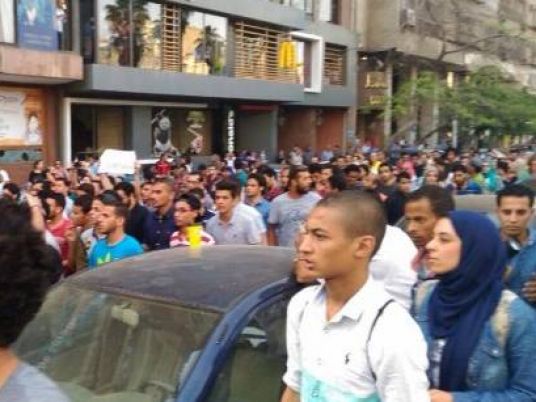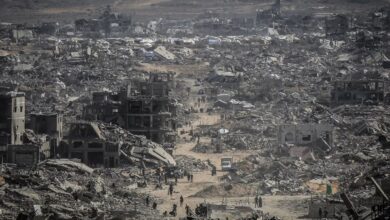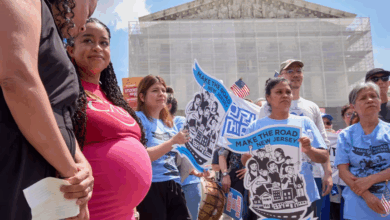
In late October, President Donald Trump lifted a temporary ban on most refugee admissions, a move that should have cleared the way for more people fleeing persecution and violence to come to the United States.
Instead, the number of refugees admitted to the country has plummeted. In the five weeks after the ban was lifted, 40 percent fewer people were allowed in than in the last five weeks it was in place, according to a Reuters analysis of State Department data. That plunge has gone almost unnoticed.
As he lifted the ban, Trump instituted new rules for tougher vetting of applicants and also effectively halted, at least for now, the entry of refugees from 11 countries deemed as high risk. The latter move has contributed significantly to the precipitous drop in the number of refugees being admitted.
The data shows that the Trump administration’s new restrictions have proven to be a far greater barrier to refugees than even his temporary ban, which was limited in scope by the Supreme Court.
The State Department data shows that the kind of refugees being allowed in has also changed. A far smaller portion are Muslim. When the ban was in place they made up a quarter of all refugees. Now that it has been lifted they represent just under 10 percent.
Admissions over five weeks is a limited sample from which to draw broad conclusions, and resettlement numbers often pick up later in the fiscal year, which began in October. But the sharp drop has alarmed refugee advocates.
“They’re pretty much shutting the refugee program down without having to say that’s what they’re doing,” said Eric Schwartz, president of Refugees International. “They’ve gotten better at using bureaucratic methods and national security arguments to achieve nefarious and unjustifiable objectives.”
Trump administration officials say the temporary ban on refugees, and the new security procedures that followed, served to protect Americans from potential terrorist attacks.
Supporters of the administration’s move also argue that the refugee programme needed reform and that making it more stringent will ultimately strengthen it.
“The programme needed to be tightened up,” said Joshua Meservey, a senior policy analyst at the Heritage Foundation, a conservative think tank, who formerly worked in refugee resettlement in Africa. “I’m all for strengthening the vetting, cracking down on the fraud, being really intentional on who we select for this, because I think it protects the programme ultimately when we do that.”
A State Department official attributed the drop in refugee admissions to increased vetting, reviews aimed at identifying potential threats, and a smaller annual refugee quota this year of 45,000, the lowest level in decades.
“Refugee admissions rarely happen at a steady pace and in many years start out low and increase throughout the year. It would be premature to assess (the 2018 fiscal year’s) pace at this point,” the official said, speaking on condition of anonymity.
Trump has made controlling immigration a centrepiece of his presidency, citing both a desire to protect American jobs and national security. During the 2016 presidential campaign he said Syrian refugees could be aligned with Islamist militants and promised “extreme vetting” of applicants.
The White House did not respond to a request for comment.
New rules, more info
After the ban was lifted the new rules imposed included a requirement that refugees provide 10 years of biographical information, rather than five years, a pause in a programme that allows for family reunification, and a “detailed threat analysis and review” of refugees from 11 countries. A Department of Homeland Security spokesman said that 90-day review began on October 25, the day after Trump lifted the ban.
Officials have said that during the review period, refugees from Egypt, Iran, Iraq, Libya, Mali, North Korea, Somalia, South Sudan, Sudan, Syria and Yemen will be allowed in on a case by case basis, but they have also said priority will be given to other applicants.
For each of the last three years, refugees from the 11 countries made up more than 40 percent of US admissions. While nine of the 11 countries are majority Muslim, it is often their religious minorities, including Christians and Jews, who seek asylum in the United States.
And in practice, of the 11 countries only Iran, Iraq, Somalia, South Sudan, Sudan and Syria produce refugees who resettle in the United States in meaningful numbers.
Trump administration officials have said the 90-day review does not amount to a bar on refugees from the 11 countries. But just as the review launched, the number of refugees coming from those countries ceased almost entirely.
In the five weeks before the ban was lifted, 587 refugees from the 11 countries were allowed in, despite tough eligibility rules, according to the Reuters review of the State Department data. In the five weeks after Trump lifted the ban, just 15 refugees from those countries were allowed in.
From all countries, 1,469 refugees were admitted to the United States in the five weeks between October 25 and November 28, according to the State Department data. That was 41 percent lower than during the final five weeks of the ban, when nearly 2,500 refugees gained entry.
Just 9 percent of refugees admitted to the United States between October 25 and November 28 were Muslim, and 63 percent were Christian. In the five weeks prior, 26 percent were Muslim and 55 percent were Christian.
More refugees were allowed in during the period the temporary refugee ban was in place because the Supreme Court, in okaying the ban in June, required refugees with “bona fide” ties to the United States be exempted. The new rules have been challenged in court, but no rulings have yet been issued.
In limbo
Each twist in US refugee policy has left Alireza, a gay Iranian refugee living in Turkey, confused, desperate for information, and less hopeful he will ever make it to the United States.
Alireza, 34, had already been interviewed by US officials and was on track for resettlement when Trump issued his first refugee ban in January. He declined to share his last name because his family does not know he is gay, but he shared documents with Reuters on his case to confirm his identity and refugee status.
When Trump’s ban was initially blocked by federal courts, Alireza was able to continue the vetting process and was close to the point of being resettled. Then came the Supreme Court ruling reinstating the ban, and then the new restrictions replacing the ban. As a refugee from one of the 11 countries targeted for additional scrutiny, he is once again in limbo.
Alireza questions the national security logic of the new review. He and his boyfriend of 13 years fled to Turkey in 2014 after facing harassment, beatings and extortion in Iran. Human rights groups say that discriminatory laws in Iran against sexual minorities put them at risk of harassment and violence.
In Turkey, he said, they scrape by with unstable part-time work and feel threatened by what they see as a rise in anti-gay sentiment in Turkish society.
“We ourselves have been hurt by the Islamist system in Iran,” he said in a recent telephone interview from Eskisehir, in northwestern Turkey. “Why would we suffer for three years (in Turkey) so that we could come to America and commit terrorism?”




